Papers by Po-Shiuan Hsieh
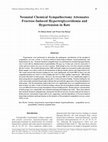
PubMed, Mar 31, 2001
Experiments were performed to determine the pathogenic contribution of the peripheral sympathetic... more Experiments were performed to determine the pathogenic contribution of the peripheral sympathetic nervous system to fructose-induced hypertriglyceridemia, hyperinsulinemia and hypertension in rats. Neonatal chemical sympathectomy was performed in neonatal Sprague-Dawley rats (1-week old) by administration of guanethidine (50 microg/g, i.p.) 5 times per week for consecutive 3 weeks and nerve-intact rats were served as controls. Both groups of rats were fed a fructose-enriched diet for 9 weeks. The systolic blood pressure (SBP) and body weight were measured weekly and arterial blood samples were taken weekly for determinations of plasma insulin, glucose and triglyceride levels. The results showed that fructose feeding for one week significantly increased SBP in intact rats and sympathectomized rats (116+/-1 to 119+/-1 mmHg and 116+/-1 to 120+/-1 mmHg, respectively). SBP further increased thereafter in both groups. However, the increased SBP levels were significantly higher in intact group than in sympathectomized group after 5 weeks of fructose feeding. Fructose feeding for one week concurrently produced hypertriglyceridemia that preceded the appearance of hyperinsulinemia in both groups. The elevated plasma triglyceride levels were significantly lower in sympathectomized rats than in intact rats after 3 weeks of fructose feeding, whereas the elevated plasma insulin concentrations were not different between groups throughout fructose feeding period. Plasma glucose concentrations of both groups were comparable and remained unchanged throughout the study. These data indicate that neonatal chemical sympathectomy attenuated, but did not prevent, fructose-induced elevations in blood pressure and plasma triglyceride levels, suggesting a partial dependency of fructose-induced hypertriglyceridemia and hypertension on the integrity of the peripheral sympathetic nervous system (SNS) in rats.
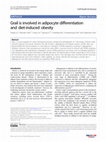
Cell Death and Disease, May 9, 2018
Grail is a crucial regulator of various biological processes, including the development of T-cell... more Grail is a crucial regulator of various biological processes, including the development of T-cell anergy, antiviral innate immune response, and cancer. However, the role of Grail in adipogenesis and obesity remains unclear. Here, we demonstrated that Grail knockdown in vitro leads to a decrease in PPARγ expression, resulting in adipogenesis inhibition. However, Grail overexpression induced the same effects. Grail was shown to interact with PPARγ, targeting it for degradation and modulating its adipogenic activity. PPARγ expression was shown to be considerably reduced in Grail knockout (KO) mice fed normal diet or high-fat diet (HFD). The administration of both normal diet or HFD to Grail KO mice led to lower adipose mass and body weight than those in the wild-type mice. HFD-fed Grail KO mice had improved glucose and insulin tolerance. Taken together, our results indicate that Grail plays a pivotal role in adipogenesis and diet-induced obesity by regulating PPARγ activity.

台灣癌症醫學雜誌, Dec 1, 2011
Obesity is reaching epidemic levels worldwide, a troubling phenomenon that increases the risk of ... more Obesity is reaching epidemic levels worldwide, a troubling phenomenon that increases the risk of cardiovascular diseases and type 2 diabetes. Recently, it has been suggested that obesity has a pathological link with cancer. Obesity is strongly associated with changes in the physiological function of adipose tissue, leading to insulin resistance, chronic inflammation, and altered secretion of adipokines. Several of these factors are directly involved in carcinogenesis and cancer progression, such as insulin resistance, increased levels of leptin, plasminogen activator inhibitor-1, endogenous sex steroids, decreased levels of adiponectin, and chronic inflammation. Additionally, adipose tissue has also been hypothesized to act as a reservoir for lipophilic, liposoluble environmental carcinogens, so that chemical pollution may indirectly promote both overweight/obesity and cancer. Moreover, it has also been suggested that many carcinogens stored in the adipose tissue could be released in periodic doses in the circulatory system and therefore target peripheral tissues to induce carcinogenesis. Such carcinogens mainly include organochlorine pesticides and polychlorinated biphenyls (PCBs). Their association with an increased risk of cancer appears to have been demonstrated for breast and prostate carcinoma, as well as for lymphoma. In this study, we reviewed the relevant evidence focusing on adipose tissue dysfunction as a unifying causal factor for cancer, as well as the hypothesis of chemical pollutants and their link to obesity and carcinogenesis.
British Journal of Pharmacology
Biomedicines
This article is an open access article distributed under the terms and conditions of the Creative... more This article is an open access article distributed under the terms and conditions of the Creative Commons Attribution (CC BY
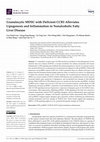
International Journal of Molecular Sciences
C-C chemokine receptor type 5 (CCR5) positively contributes to the pathogenesis of nonalcoholic f... more C-C chemokine receptor type 5 (CCR5) positively contributes to the pathogenesis of nonalcoholic fatty liver disease (NAFLD), a common metabolic liver disease associated with chronic inflammation. CCR5 signaling also facilitates the immunosuppressive activity of a group of immature myeloid cells known as granulocytic myeloid-derived suppressor cells (g-MDSCs). While both hepatocyte and g-MDSC express CCR5, how CCR5 coordinates these two distinct cell types in the hepatic microenvironment remains largely unknown. Here, we used in vivo and ex vivo approaches to define the molecular details of how CCR5 mediates the crosstalk between hepatocytes and g-MDSCs in a mouse model of NAFLD. Global CCR5-deficient mice exhibited more severe steatosis, increased hepatic gene expression of lipogenesis, and exacerbated liver damage in diet-induced obesity. Either NAFLD or CCR5-deficiency per se is causative for the increase of g-MDSCs. Purified g-MDSCs have a higher survival rate in the fatty liver ...
Journal of the Chinese Medical Association
References and Tables.

Copyright © 2015 Kuo-Sheng Wu et al.This is an open access article distributed under the Creative... more Copyright © 2015 Kuo-Sheng Wu et al.This is an open access article distributed under the Creative Commons Attribution License, which permits unrestricted use, distribution, and reproduction in any medium, provided the original work is properly cited. Growth arrest-specific 6 (GAS6), a vitamin K-dependent protein, plays a role in the survival, proliferation, migration, differentiation, adhesion, and apoptosis of cells. GAS6 is highly expressed during growth arrest, followed by a sharp decrease during differentiation in adipocytes. The functions of GAS6 signaling are limited to TAM (Tyro3, Axl, and Mer) receptors and are dependent on the cell type. While many studies have focused on the role of GAS6 in inflammation and cancer, only few studies focused on its roles of GAS6 in obesity. Accordingly, the participation of GAS6 in the progression of obesity remains controversial. In this review, we summarize the results of current studies from clinical and basic research to elucidate the po...
She has vast experience in teaching at home and abroad. She is active in writing, has published n... more She has vast experience in teaching at home and abroad. She is active in writing, has published numerous articles in scientific journals, works as an editorial board member and reviewer of academic journals and is involved in nutrition related research and activities.

Biomedical Journal, 2021
Background s: While severe acute respiratory syndrome coronavirus 2 (SARS-CoV-2) infection presen... more Background s: While severe acute respiratory syndrome coronavirus 2 (SARS-CoV-2) infection presents with mild or no symptoms in most cases, a significant number of patients become critically ill. Remdesivir has been approved for the treatment of coronavirus disease 2019 (COVID-19) in several countries, but its use as monotherapy has not substantially lowered mortality rates. Because agents from traditional Chinese medicine (TCM) have been successfully utilized to treat pandemic and endemic diseases, we designed the current study to identify novel anti-SARS-CoV-2 agents from TCM. Materials and methods We initially used an antivirus-induced cell death assay to screen a panel of herbal extracts. The inhibition of the viral infection step was investigated through a time-of-drug-addition assay, whereas a plaque reduction assay was carried out to validate the antiviral activity. Direct interaction of the candidate TCM compound with viral particles was assessed using a viral inactivation assay. Finally, the potential synergistic efficacy of remdesivir and the TCM compound was examined with a combination assay. Results The herbal medicine Perilla leaf extract (PLE, approval number 022427 issued by the Department of Health and Welfare of Taiwan) had EC50 of 0.12 ± 0.06 mg/mL against SARS-CoV-2 in Vero E6 cells – with a selectivity index of 40.65. Non-cytotoxic PLE concentrations were capable of blocking viral RNA and protein synthesis. In addition, they significantly decreased virus-induced cytokine release and viral protein/RNA levels in the human lung epithelial cell line Calu-3. PLE inhibited viral replication by inactivating the virion and showed additive-to-synergistic efficacy against SARS-CoV-2 when used in combination with remdesivir. Conclusions Our results demonstrate for the first time that PLE is capable of inhibiting SARS-CoV-2 replication by inactivating the virion. Our data may prompt additional investigation on the clinical usefulness of PLE for preventing or treating COVID-19.
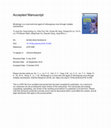
Antiviral Research, 2018
The chikungunya virus (CHIKV) is a mosquito-borne virus that belongs to the genus Alphavirus, fam... more The chikungunya virus (CHIKV) is a mosquito-borne virus that belongs to the genus Alphavirus, family Togaviridae. It is the cause of chikungunya fever in humans, which presents a serious global threat due to its high rate of contagion. The clinical symptoms of CHIKV include fever and persistent, severe arthritis. Micafungin has broad-spectrum fungicidal activity against Candida spp. is a promising echinocandin that was recently approved by the U.S. Food and Drug Administration (FDA) and has demonstrated activity against Candida and Aspergillus. Recent studies have demonstrated the antiviral activity of micafungin; however, the inhibitory effects against CHIKV have yet to be investigated. Our objectives in this study were to explore the antiviral effects of micafungin on CHIKV infection and to elucidate the potential molecular mechanisms of inhibition. We determined that micafungin has the ability to counter CHIKV-induced cytopathic effects. We further discovered that micafungin limits virus replication, release, cell-to-cell transmission, and also slightly affected virus stability during high doses treatment. The efficacy of micafungin was further confirmed against two clinical isolates of CHIKV and

Frontiers in Immunology
BackgroundDrug repurposing is a fast and effective way to develop drugs for an emerging disease s... more BackgroundDrug repurposing is a fast and effective way to develop drugs for an emerging disease such as COVID-19. The main challenges of effective drug repurposing are the discoveries of the right therapeutic targets and the right drugs for combating the disease.MethodsHere, we present a systematic repurposing approach, combining Homopharma and hierarchal systems biology networks (HiSBiN), to predict 327 therapeutic targets and 21,233 drug-target interactions of 1,592 FDA drugs for COVID-19. Among these multi-target drugs, eight candidates (along with pimozide and valsartan) were tested and methotrexate was identified to affect 14 therapeutic targets suppressing SARS-CoV-2 entry, viral replication, and COVID-19 pathologies. Through the use of in vitro (EC50 = 0.4 μM) and in vivo models, we show that methotrexate is able to inhibit COVID-19 via multiple mechanisms.ResultsOur in vitro studies illustrate that methotrexate can suppress SARS-CoV-2 entry and replication by targeting furin...
International Journal of Molecular Sciences, Nov 17, 2022
This article is an open access article distributed under the terms and conditions of the Creative... more This article is an open access article distributed under the terms and conditions of the Creative Commons Attribution (CC BY
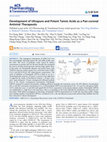
ACS Pharmacology & Translational Science
The rampageous transmission of SARS-CoV-2 has been devastatingly impacting human life and public ... more The rampageous transmission of SARS-CoV-2 has been devastatingly impacting human life and public health since late 2019. The waves of pandemic events caused by distinct coronaviruses at present and over the past decades have prompted the need to develop broad-spectrum antiviral drugs against them. In this study, our Pentarlandir ultrapure and potent tannic acids (UPPTA) showed activities against two coronaviral strains, SARS-CoV-2 and HCoV-OC43, the earliest-known coronaviruses. The mode of inhibition of Pentarlandir UPPTA is likely to act on 3chymotrypsin-like protease (3CLpro) to prevent viral replication, as supported by results of biochemical analysis, a 3CLpro assay, and a "gain-of-function" 3CLpro overexpressed cell-based method. Even in the 3CLpro overexpressed environment, Pentarlandir UPPTA remained its antiviral characteristic. Utilizing cell-based virucidal and cytotoxicity assays, the 50% effective concentrations (EC 50) and 50% cytotoxicity concentration (CC 50) of Pentarlandir UPPTA were determined to be ∼0.5 and 52.5 μM against SARS-CoV-2, while they were 1.3 and 205.9 μM against HCoV-OC43, respectively. In the pharmacokinetic studies, Pentarlandir UPPTA was distributable at a high level to the lung tissue with no accumulation in the body, although the distribution was affected by the food effect. With further investigation in toxicology, Pentarlandir UPPTA demonstrated an overall safe toxicology profile. Taking these findings together, Pentarlandir UPPTA is considered to be a safe and efficacious pancoronal antiviral drug candidate that has been advanced to clinical development.

Journal of Medical Sciences, 2010
Background: Portal endotoxemia has been speculated to be crucially involved in the pathogenesis o... more Background: Portal endotoxemia has been speculated to be crucially involved in the pathogenesis of chronic hepatic inflammation which is highly associated with the development of type 2 diabetes mellitus (T2DM). This study examined whether portal endotoxemia was a pathogenic link between chronic subacute hepatic inflammation and systemic insulin resistance. Methods: Rats were randomly assigned into four groups: rats with intraportal saline or with three different doses of lipopolysaccharide (LPS) infusion for 4 wks. Pathological changes in the liver were evaluated via histological and biochemical examination. Systemic insulin sensitivity was evaluated by euglycemic hyperinsulinemic clamp by the tracer dilution method. Results: Body weight, fasting whole blood glucose, plasma insulin, triglyceride levels, mean arterial blood pressure and heart rate were not significantly changed in the four-week infusion period for all groups. The biochemical indicators of hepatic function such as as...
Journal of Medical Sciences, 1992
Chloride channels in intestinal epithalia act together with other ion transporters to midiate abs... more Chloride channels in intestinal epithalia act together with other ion transporters to midiate absorption or secretion of water and electrolytes. In cystic fibrosis (CF) which is a lethal genetic disease, the intestinal CF secretion is impaired. Normally, CF channels can be activated by an increase in intracellular level of cAMP or Ca^(2+). In contrast, the CF intestinal epithelia do not respond to either cAMP- or Ca^(2+)-mediated secretagogues. The gene responsible for CF has recently been identified and the protein it encodes has been termed CF transmembrane conductance regulator (CFTR). Convincing evidence suggests that CFTR is a chloride channel. Further studies needs to elucidate the mechanisms by which this gene defect alters the electrolyte transport.
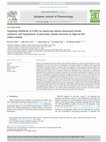
European Journal of Pharmacology, 2021
Obesity is closely linked with type 2 diabetes and the effective therapies on obesity-associated ... more Obesity is closely linked with type 2 diabetes and the effective therapies on obesity-associated diabetes are under development. The aim of this study was undertaken to investigate whether the inhibition of the augmented CCR5-mediated signaling could be a common target for treatment of obesity-associated insulin resistance and impairment of pancreatic insulin secretion in high-fat diet (HFD) fed rats and CCR5 knockout mice and also in isolated islets and RIN-m5F cells. Conducted with SD rats, HFD-induced body weight gain was significantly decreased in those combined with Maraviroc treatment, but food intake remained similar compared to control. Maraviroc also significantly improved the impaired oral glucose tolerance test (OGTT). As compared with wildtype mice, CCR5 deletion significantly attenuated the HFD-induced increases in glucose area under curve of OGTT and the value of HOMA-IR as well as plasma lipid profile. It also reversed the HFD-suppressed gene expressions of GLUT4 and IRS-1 in adipose tissue. On the other hand, the HFD-associated islet macrophage and Tcell infiltration were significantly decreased in CCR5 KO mice. H 2 O 2 significantly suppressed glucose-stimulated insulin secretion (GSIS) is isolated islets, which were significantly reversed in those cotreated with CCR5 mAb. H 2 O 2 failed to change GSIS in those of CCR5 KO mice. The palmitate-induced reactive oxygen species production was significantly decreased in those cotreated with CCR5 antagonist in RIN-m5F cells. Collectively, it is suggested that targeting inhibition of the CCR5 mediated inflammatory pathway could not only improve obesityassociated insulin resistance but also directly alleviate pancreatic β-cell dysfunction.
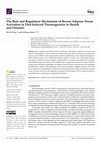
International Journal of Molecular Sciences
Brown adipose tissue (BAT) has been considered a vital organ in response to non-shivering adaptiv... more Brown adipose tissue (BAT) has been considered a vital organ in response to non-shivering adaptive thermogenesis, which could be activated during cold exposure through the sympathetic nervous system (SNS) or under postprandial conditions contributing to diet-induced thermogenesis (DIT). Humans prefer to live within their thermal comfort or neutral zone with minimal energy expenditure created by wearing clothing, making shelters, or using an air conditioner to regulate their ambient temperature; thereby, DIT would become an important mechanism to counter-regulate energy intake and lipid accumulation. In addition, there has been a long interest in the intriguing possibility that a defect in DIT predisposes one to obesity and other metabolic diseases. Due to the recent advances in methodology to evaluate the functional activity of BAT and DIT, this updated review will focus on the role and regulatory mechanism of BAT biology in DIT in health and diseases and whether these mechanisms ar...
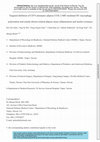
Clinical Science, 2018
Adipose tissue (AT) inflammation is crucial to the development of obesity-associated insulin resi... more Adipose tissue (AT) inflammation is crucial to the development of obesity-associated insulin resistance. Our aim was to investigate the contribution of cyclooxygenase-2 (COX-2)/macrophage migration inhibitory factor (MIF)-mediated cross-talk between hypertrophic adipocytes and macrophages to the etiology of AT inflammation and the involvement of CD74 using human SGBS adipocytes, THP-1 macrophages and mice fed a high-fat (HF) diet. The MIF and CD74 mRNA levels in the adipocytes and stromal vascular cells (SVCs) of white fat were highly correlated with body weight (BW), homeostatic model assessment for insulin resistance (HOMA-IR), and adipose macrophage marker expression levels, especially those in SVCs. COX-2 inhibition suppressed the elevation of MIF production in HF white adipocytes as well as palmitate and hypoxic-treated SGBS adipocytes. Treatment of adipocytes transfected with shCOX-2 and siMIF or subjected to MIF depletion in the medium reversed the pro-inflammatory responses ...

Obesity, 2009
The aim was to examine the role of cyclooxygenase (COX)-2-mediated inflammation in the developmen... more The aim was to examine the role of cyclooxygenase (COX)-2-mediated inflammation in the development of obese linked insulin resistance and fatty liver. The rats were fed separately regular diet (CONT), high-fat diet (HFD) ad libitum, or energy restrictedly for 12 weeks. Rats fed HFD ad libitum were further divided into three subgroups co-treated with vehicle (HFa), or a selective COX-2 inhibitor celecoxib (HFa-Cel) or mesulid (HFa-Mes). Euglycemic hyperinsulinemic clamp (EHC) experiment was performed at the end of study. Another set of rats with similar grouping was further divided into those with a 4, 8, or 12-week intervention period for hepatic sampling. Body weight was increased significantly and similarly in HFa, HFa-Cel, and HFa-Mes. Time-dependent increases in plasma insulin, glucose, 8-isoprostanes, leptin levels, homeostasis model assessment of insulin resistance (HOMA-IR) and hepatic triglyceride contents shown in HFa were significantly reversed in HFa-Cel and HFa-Mes. During EHC period, the reduction in stimulation of whole body glucose uptake, suppression of hepatic glucose production and metabolic clearance rate of insulin shown in HFa were significantly reversed in HFa-Cel and HFa-Mes. The enhanced COX-2 and tumor necrosis factor-alpha (TNF-alpha) but attenuated PPAR-gamma and C/EBP-alpha mRNA expressions in epididymal fat shown in HFa were significantly reversed in HFa-Cel and HFa-Mes. The increases in average cell size of adipocytes and CD68 positive cells shown in HFa were also significantly reversed in HFa-Cel and HFa-Mes. Our findings suggest that COX-2 activation in fat inflammation is important in the development of insulin resistance and fatty liver in high fat induced obese rats.






Uploads
Papers by Po-Shiuan Hsieh